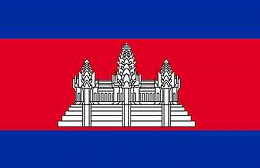Human rights in Cambodia have gone from bad to worse in January, prompting Human Rights Watch to issue a damning report on the Southeast Asian nation’s rights slide.
The Cambodian government has been especially rough on protesters demonstrating against an apparent land grab. Rampant government-backed private development means those unlucky enough to live in the path of progress are taking to the streets in a desperate attempt to find justice.
January has already seen the violent eviction of hundreds from their former homes at the Borei Keila slum—forcing over 300 “extra” families not provided for by the Phan Imex development company to take to the streets of the capital city of Phnom Penh. Eight were arrested in the eviction fray for resisting the government, and remain in prison.
The company eventually provided some former villagers with plots of land at relocation sites, but the desolate sites were 50 km from the capital, without bathrooms, schools, hygiene provisions or even buildings.
Many villagers had to pay for even these plots, and those whose documents were destroyed in the wreckage, or who couldn’t pay up, were forced to squat on the sites.
Hundreds of the former Borei Keila residents had returned to the rubble of their former homes, deciding sleeping amidst rebar and brick was a better deal than a far-off and increasingly filthy “relocation” camp.
Some evictees who didn’t get in line were abused: 30 women and children were thrown into a van and sent to the Prey Speu detention center in the middle of a peaceful Jan 11 protest.
They were kept at the prison-like detention center for over a week, as the government, in a distressingly Orwellian turn of phrase “tried to find out what their real needs and intentions were.”
20 detainees escaped the center when Sam Rainsy Party lawmaker and human rights activist Mu Sochua snuck into the center, and pointed out (correctly) that the government had no right to detain them.
The Borei Keila residents aren’t the only Cambodians who have felt the government’s wrath this month. Four protesters were shot and injured last week in the small town of Snoul, located on the way to Siem Reap during a land grab dispute.
Protesting a rubber company’s seizure of their farmland—a company whose director is an adviser to Cambodian Prime Minister Hun Sen—300 poor villagers blocked the road—prompting company security guards to fire into the crowd with AK-47s.
The government promised to find and prosecute the killers, but to no one’s surprise, no arrests have been made—and newspaper reports indicate the “investigation” is tepid at best.
In a positive development, villagers may now be able to keep their land, after the government leaned on the rubber company to recompense them.
A positive move but probably not a pure one: the bad publicity of the shootings was probably a power motivator.
Human Rights Watch annual report on Cambodia was grim, decrying government interference in the Khmer Rouge War Tribunal, a biased and unfair judiciary, and persistent government threats to free speech and peaceful protests. According to the report, over 60 Cambodians are imprisoned or awaiting trial for protesting land grabs. The report also fingered foreign donors, pointing out: “Foreign assistance accounts for over 50 percent of Cambodia’s budget, yet donors have said little about Cambodia’s worsening human right’s environment.”
The ignored Borei Keila evictees, who protested at almost every Western embassy in Phnom Penh with no result, would agree with HRW’s assessment.
Cambodia’s worsening human rights record is especially embarrassing when compared to Myanmar, where a brutal military junta has of late decided to de-fang itself and take a more human-rights friendly path.
Cambodia, fond of proclaiming its commitment to both democracy and free speech, appears to be leaning towards the authoritarian policies of China instead.
Which is unfortunate: China’s rampant land-grabs and ruthless quashing of government dissent have proved the dark side of its economic miracle.
Using these tactics may accelerate Cambodia’s development and help a war-torn and poor country modernize quicker—but at what human cost?
